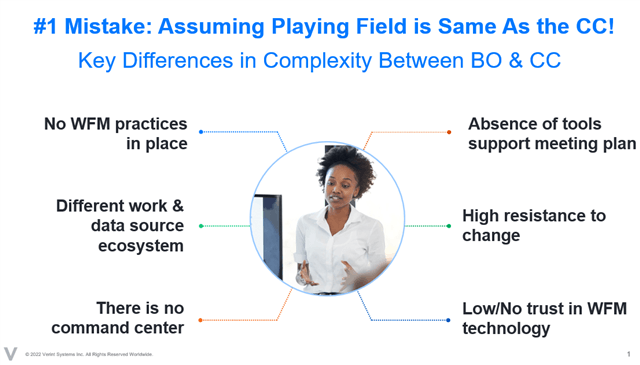
Top 6 Challenges in Extending WFM Beyond the Contact Center


At the recent Society of Workforce Planning Professionals (SWPP) conference, industry leaders in workforce planning discussed the growing challenges and growing demand to extend workforce management software (WFM) beyond the contact center. They agreed the growing operational complexities mean you can’t use the same blueprint for WFM in the contact center and apply it to back office operations.
Let me explain.
Organizations have a big challenge today. There is an ever-increasing scarcity of skilled workers inhibiting the ability to get work done, and deliver this work at the right cost and with a great customer experience. We call this the Engagement Capacity Gap—not having enough resources to meet growing customer demand. Closing this gap is getting even more challenging because employees now have greater choice in the job market. In addition, the growing number of channels and complexity of un-automated work is making it more challenging to measure and manage employee performance.
Employee Choice and Attrition
With the prevalence of remote working, employees can now apply for jobs anywhere, creating more opportunities than they had before. For the contact center, attrition has always been an issue and this has accelerated it.
In back office operations the employees who process the actual customer work—claims processing, underwriting, transaction processing, etc.—used to stick around, but not anymore. This threatens the ability for organizations to keep skilled employees with deep institutional and industry knowledge. In addition, younger generations not only want the flexibility to allow them to work where and when they want, they also want to work for innovative organizations. They often change jobs frequently to build their resumes.
Complexity of Work
Many organizations have turned to automation to try and close the Engagement Capacity Gap. However, even with new digital and self-service channels, organizations still have a large volume of employees to do the work that could not automated. Savvy leaders are solving the problem of limited resources by embracing a “one workforce” approach. Their strategy is to break down the functional silos between the contact center and back office operations, so they can leverage resources across functions to better handle the ebbs and flows in customer demand. To do so effectively, they need to extend WFM from the contact center into the back-office.
This may seem daunting as the back office can have three to 10 times as many employees as the contact center, working in different departments and locations. The biggest mistake we have seen made is assuming WFM will work the same in the back office as in the contact center. The secret to success is acknowledging that the WFM playing field is very different between the two.

There are different complexities to take into account. Let’s explore them:
The Differences in Complexity between the Contact Center and Back Office
| Challenges | ||
| Contact Center | Back Office | |
| WFM Practices | Practices are consistent and embedded. In the contact center, these practices are built around product capabilities, which is a challenge if/when you change WFM providers. | Though often incomplete, business practices may exist. Typically they are inconsistent from manager to manager, making it difficult for leaders as they can’t see the big/whole picture. |
| Ecosystem | The ACD as the center of the universe is shrinking, especially with the increase in digital channels a customer can use to reach the contact center. This makes WFM more complex and requires expanded integrations.
| There is no single source of truth – a multitude of disconnected systems that often differ between functional areas within operations. None are built with back-office WFM in mind. It may not be easy to get the data needed.
Work is defined granularly. Multiple attributes come together to determine the type of task, creating complex modeling (1000+ work tasks) and lengthy data integration discussions.
|
| Command Center | Centralized or hub and spoke command centers are the norm. Front line leaders focus on employee performance. | Managers and front-line managers oversee all management of resources and work. |
| Manage Employee Performance to Forecast (Optimized Schedule / Capacity Plan) | The ACD, WFM Adherence, and Performance Management metrics support managing employee performance.
The increase in customer contact channels has created new obstacles to fully managing performance. | The challenge is automated tools that do this don’t exist in the back office. Homegrown tools or excel are used, and everyone uses different tools. Data interpretation is vastly different.
As a result, managers have the challenge of managing employee performance to focus on production work and complete it at the right pace. That challenge makes the WFM forecast appear not fit for purpose.
|
| Resistance to Change | Transitioning between WFM solutions is a challenge, specifically in overcoming loyalty to the prior system and adapting systematic differences between technologies.
| Managers are used to their independence and hold on to their homegrown tools; they do not want to relinquish control.
Real-time measurement is new, and people are concerned about privacy and misuse. |
| Trust in WFM Technology | WFM is entrenched and proven; the challenge is having trust when there is a change in WFM systems. | Trust is low. It is often the first implementation of WFM in the department, making it unproven. |
You are probably asking yourself, “This is great—you’ve outlined all the challenges, but how do I move forward?” Look for my next blog, where I’ll explore how to overcome each of these challenges.

